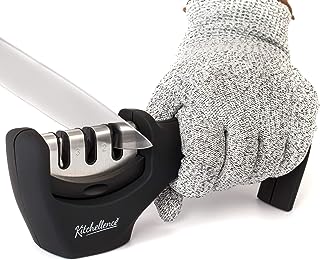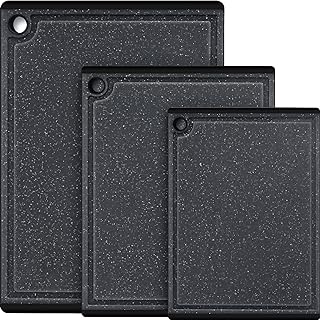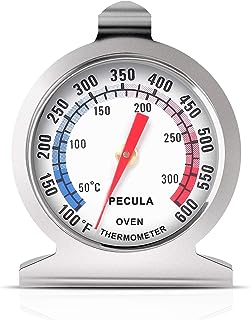5 important factors worth considering when looking for the best cutting boards
Choosing the right cutting board is important for your kitchen. Cutting boards are more than just accessories – they are essential for preparing food and can make a big difference in how well you cook. When you’re looking for a cutting board, it’s important to think about more than just how it looks. You should consider things like what it’s made of, how big it is, how long it will last, and how easy it is to clean. All of these factors affect not only your cooking but also how well your kitchen works overall. Making a thoughtful choice about your cutting board can improve your experience in the kitchen, where you spend a lot of time.
See our guide to the best cutting boards.
Material
When you’re choosing a cutting board, the material you pick is important for how well it works and how long it lasts. Wooden cutting boards are classic and gentle on knives, plus they have natural properties that fight bacteria. Plastic cutting boards are tough, easy to clean, and come in different colors to brighten up your kitchen. But they can get cut up and hold onto germs after a while.
If you want a mix of style and usefulness, bamboo cutting boards are a good choice. Bamboo grows fast and is good for the environment. It’s strong and lasts a long time, and its dense surface is great for cutting food. With the right care, bamboo cutting boards can last for years, giving you both function and fashion.
When you’re picking a cutting board material, think about what you like, how you cook, and how sustainable it is. This way, you can have a cutting board that works well and respects the Earth at the same time.
Size and thickness
When choosing a cutting board, it’s important to find one that meets your cooking needs. A larger board gives you more space to work with ingredients, making food prep easier. However, a board that is too thick might be harder to handle and store, causing inconvenience while cooking. It’s important to think about these factors carefully so that your cutting board helps, rather than hinders, your cooking experience.
In addition, the thickness of a cutting board can affect its durability and stability. Thicker boards are stronger and less likely to bend or break, lasting longer in your kitchen. Thinner boards are easier to handle and store, which is useful for those with limited space. Ultimately, whether you prioritize size or thickness depends on your personal preferences and what works best for you. By considering how you cook and the space you have, you can find the right cutting board for your culinary adventures.
Maintenance requirements
Taking care of cutting boards is important for keeping them in good condition and preventing bacteria build-up. Choosing high-quality wooden cutting boards like maple or walnut can add durability and style to your kitchen. However, it’s essential to regularly oil and clean wooden boards to prevent damage. Plastic cutting boards are easy to clean in the dishwasher, but they can develop deep grooves where bacteria can hide if not replaced regularly.
Maintaining cutting boards promotes a healthy cooking environment and improves the kitchen experience. Being proactive with upkeep can help extend the life of your boards and reduce waste. Simple practices like sanding wooden boards or disinfecting plastic ones with vinegar can help sustain a eco-friendly kitchen. Using quality maintenance products like mineral oil or board cream shows a commitment to cooking. Following these care instructions not only preserves the function and appearance of cutting boards but also creates a clean and creative kitchen space.
Durability
When choosing a cutting board, it’s important to consider durability. A strong cutting board that can handle daily use in the kitchen is essential. Opt for a board made from quality materials like bamboo, hardwood, or plastic. This will not only make your cutting board last longer, but also keep your food preparation area clean. It’s best to avoid flimsy cutting boards that can warp, crack, or fall apart with frequent use, as this can lead to safety risks and cross-contamination.
Investing in a durable cutting board is a wise decision in the long term. Although cheaper options may be tempting, constantly replacing low-quality cutting boards can end up costing more in the end. By prioritizing durability, you’re creating a safer environment for food preparation and getting a reliable kitchen tool that will last a long time. A durable cutting board is essential for improving your cooking experience and maintaining an efficient kitchen.
Knife-friendly surface
When you’re looking to buy a cutting board, it’s important to choose one that won’t damage your knives and will make cutting easier and safer. Opt for cutting boards made of bamboo or high-density polyethylene to protect your knives and keep them sharp for longer. These materials are durable and won’t dull your knives quickly, giving you a better cutting experience.
Selecting a knife-friendly cutting board surface is about more than just protecting your knives; it also helps keep your food safe. Bamboo and polyethylene cutting boards are smooth and easy to clean, preventing bacteria from building up and reducing the risk of spreading germs. By picking a cutting board with a knife-friendly surface, you not only preserve your knives but also ensure that you’re preparing meals on a clean and hygienic surface.
Conclusion
In any kitchen, a good cutting board is essential for making cooking easier and keeping your knives sharp. You can choose between a sturdy wooden board or a long-lasting plastic one, depending on what works best for you. By picking the right cutting board and taking care of it properly, you can improve your cooking skills and show that you care about using tools that are practical and good for the environment in your kitchen. Want more info on cleanse for women, check the best cleanse for women.



